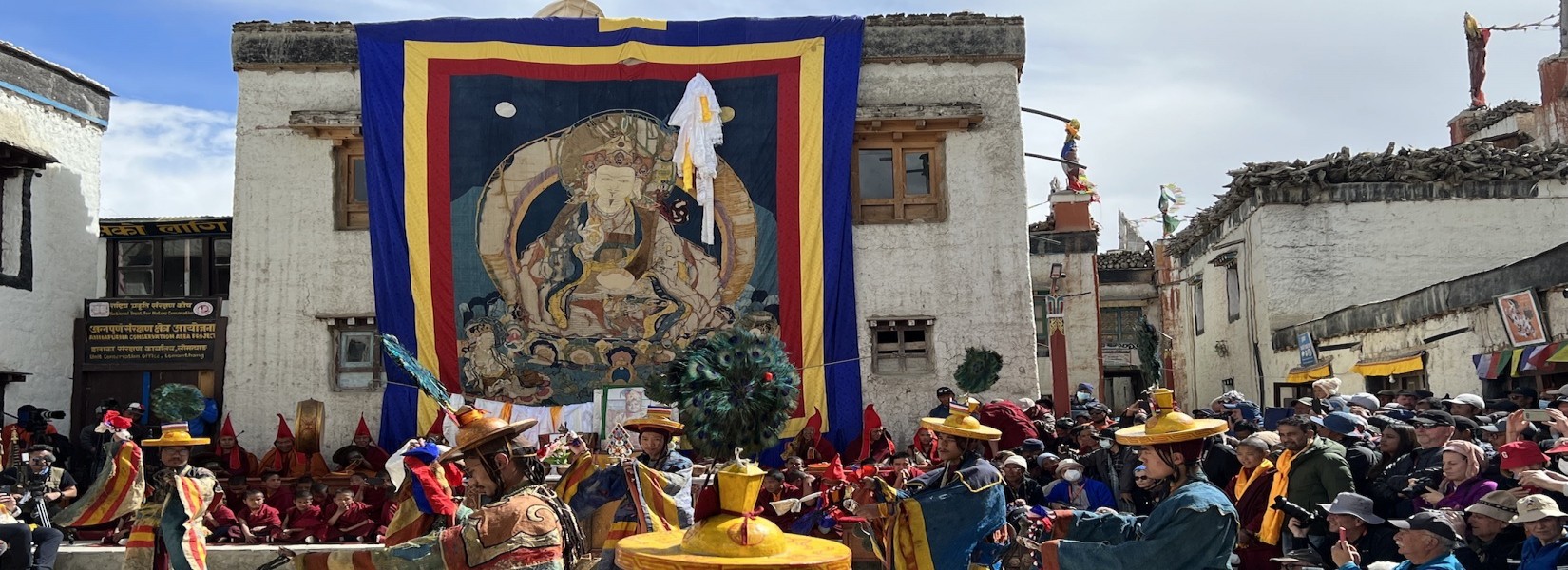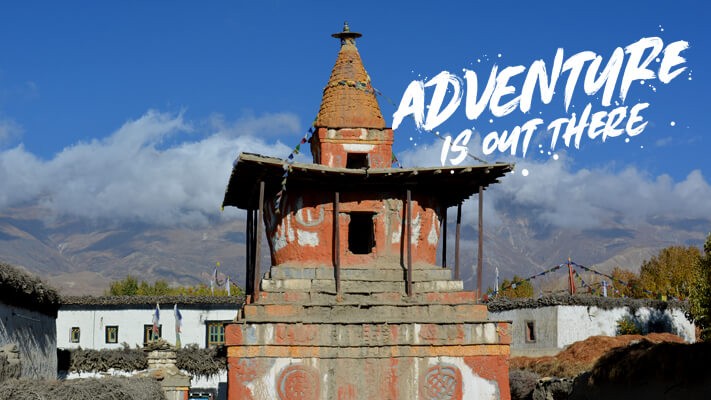Upper Mustang trek takes you around the restricted zone which is famous for its desert-like climate and harsh rock-faced landscapes. Upper Mustang is one of the best tourist destinations of Nepal which can even be visited in summer monsoon. When the lower part of Nepal goes through heavy rainfall and flood, you can explore the rain-shadow area, Upper Mustang. The geography and culture of this northern Himalayan region of Nepal match with that of Tibet rather than with Nepal.
The trek to Upper Mustang gives you an opportunity do something extraordinary without pushing your body to its limits. Simply put, our Upper Mustang trek is a fairly easy excursion to the ‘Last Forbidden Kingdom’ known locally as Lo Manthang. It lies in the remote frontiers of Nepal, which is geographically connected with Tibetan plateau with an average altitude above 3,000m.Tibetan Buddhist culture and tradition have a great influence which is proved by the ancient monasteries and festivals found here.

The small Kingdom of Lo Manthang inhabited mainly by a minority group of Tibetan origin was previously a restricted area (before 1991). Foreigners still need a special permit to embark upon this fascinating journey through incredible landscapes, prehistoric caves and age-old monasteries. A large stretch of land in Upper Mustang region is like desert despite having snow-capped mountains at its northern rim. This is why, it is often referred to as the ‘mountain desert’ of Nepal and the ‘District across the Himalayas’.
The fact that this region receives much less rainfall than other parts of Nepal makes this trek the most preferred trek during monsoon. Do you want to witness the lifestyle, culture and religion of the natives of the harsh and predominantly arid yet innately beautiful terrains? If the reply is ‘yes’, trekking to upper Mustang can quench your thirst to gain lifelong knowledge about such harsh landscapes! Additionally, there are a lot of things this trek has to offer you such bonus stopovers at Jomsom and Muktinath.

If you plan your Upper Mustang Hiking around the second week of May, you can observe Tiji Festival in Lo Manthang. This festival is organized by the monks of Chhode Monastery for three days at the premises of Lo Manthang Palace. The spectacular panorama of the snowcapped peaks of Annapurna and Dhaulagiri ranges are other assets of Upper Mustang Lo Manthang trek. The ancient Buddhist monasteries like Chhode, Tsrang, Jampa, Thubchen, Ghar and Luri are around 800 years old.

You can also visit the Sky Caves, a group of around 10,000 man-made caves close to the Kali Gandaki River. Lo Manthang trek introduces you with these caves dug to mummify the dead bodies as per the culture and tradition. A study about the Sky Caves has shown that they are archeologically important and are about 2,000 -3,000 years old. The manuscripts, Buddhist art, paintings and pottery of the caves have further clarified the report published by the study.

You can find Upper Mustang trek itinerary from 14 days to 26 days differing from one trekking agency to another. Based on your vacation, budget and willingness to travel through the mountain trail, this trekking package can be customized. For customized package of Upper Mustang trek, you can contact Orbit Alpine Adventure via phone call, email or online booking. We have presented a 17-day Upper Mustang trek itinerary in this article for your convenience.
FAQs:
1. What are the permits required for Upper Mustang trek?
To do Upper Mustang Trek, you must have TIMS card, ACAP Permit and Upper Mustang Restricted Area Trekking Permit. To collect these abovementioned permits, you can consult with Orbit Alpine Adventure.
2. How much should I spend for the permits?
You have to pay USD 500 for first 10 days’ permit of Upper Mustang Trekking and then USD 50 per additional day. Immigration Office, Kathmandu issues this permit. To get TIMS, you need to spend USD 10 and it is managed by Orbit Alpine Adventure. For Annapurna Conservation Area Project Permit, you should invest USD 27 and you get it from the entrance of ACAP.
3. Can I do this trek alone?
No, you can’t. Upper Mustang trek contains restricted zone, so you are not allowed to do this trek alone. For enjoying this trek, you must be a group of at least two members with a registered trekking guide and a porter. The trekking guide guides you through the right trail and helps in case of any emergency. Orbit Alpine Adventure is always ready to provide you a highly professional guide to make your trekking a success.
4. How can I book Upper Mustang customized trekking package?
You can book Upper Mustang customized trekking packages by searching on the web. Visit the official website of Orbit Alpine Adventure or reach us via phone call or email to book the package.
5. What are the attractions of this trek?
Upper Mustang trek is the most popular trek in Nepal because of its attractions ranging from nature to culture. You can have a mesmerizing view of the snowy peaks of Annapurna and Dhaulagiri ranges plus Mt. Machhapuchhre, Nilgiri and Tukuche peaks. You can find the perfect influence of Tibetan Buddhist culture in the lifestyle of the people of Lo Manthang. The monasteries built in the 12th or 13th centuries in almost every village reflect the Buddhist culture and tradition in this region. The dry landscapes having parched barren hills, Tibetan Plateaus and housing styles are other attractions for trekkers. The Sky Caves made to mummify the dead bodies around 2,000-3,000 years ago also draw the attention of the travelers in this region. Trekking Upper Mustang in May can show you the most colourful Tiji Festival which is celebrated for three days. The Capital City of the Last Forbidden Kingdom, Lo Manthang is the central historical site showing the ancient art and artifacts. The ethnic villages decorated with the prayer flags, mani walls, chortens and prayer wheels in the desert-like climate are worth visiting. In a nutshell, Upper Mustang is the abode for natural beauty and cultural diversity getting popularity day by day.
6. What type of trekking is this?
Talking about accommodation facilities, Upper Mustang trek is completely a teahouse trekking across the Himalayas. If you want to go on a camping trekking, Orbit Alpine Adventure helps you make the necessary arrangements. Since it is a restricted area, solo trekkers are not allowed in this region without Restricted Area Trekking Permit with extra charges. You must be two in a group supported by a registered guide and porter who can help you find the right trekking trail and in case of hurdles. Although Upper Mustang lies in Himalayan desert climatic region, there are not challenging high passes to cross en route. So, you don’t need any trekking and climbing gears except clothes and other tools for your personal use. It is moderate type of trekking in Nepal visited by thousands of trekkers every year.
7. Is there any risk of altitude sickness during this trek?
It is obvious that if you are travelling to the landscape above 3,000m, there is always possibility of altitude sickness. The highest place to go during Upper Mustang trek is Lo Manthang (3,840m), the Capital of the ancient Himalayan Kingdom. To avoid the altitude sickness or AMS (Acute Mountain Sickness), you must walk slowly as suggested by your guide. For safety measure, you must take some medicines like Acetazolamide and Diamox Oral to prevent altitude sickness.
8. Can I drink water from the local sources while in trekking?
No, you shouldn’t. Since the water of Himalayan region contains high minerals, you may not be able to digest it. If you want to drink such water, you can use medicines to purify the water or strictly filtrated one. We highly recommend you to use water purification method to prevent from health hazards or buy bottle water.
9. How is the landscape in Upper Mustang region?
The landscape of Upper Mustang is completely dry, desert-like and very much similar to that of Tibetan plateau. Since the culture and tradition of this region also match with Tibetan Buddhist culture, it is also called the ‘Mini Tibet’. You can see the desert-like climate and harsh rock-faced landscapes without any greenery.
10. What are the changes made in Annapurna region regarding trekking facilities?
In the past, Upper Mustang trek was completely a camping trekking. But nowadays, the hotels and lodges are set up in a large number to facilitate the trekkers. Similarly, road construction has been rapidly going on and let’s hope within a few years to come, it will be blacktopped. However, the road construction has caused some negative effects like pollution, destruction of trekking trail and disturbance in walking!








